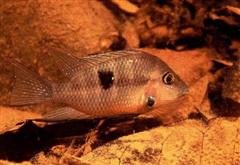Cichlid - Firemouth
Fire Mouth Cichlid Scientific Name: Thorichthys meeki
Sat, 5th July, 2025 - 9:47 pm GMT
Sponsor Ads:

Alternative Name
Fire Mouth Cichlid Scientific Name: Thorichthys meekiBasic Info
By maturity, Firemouth Cichlids usually measure five to six inches (about 13 to 15 cm) in length. The mouths of Firemouth Cichlids are various shades of red or pink, and this shading continues over the underside of the fish. The background coloration of these fish is silver, often with a yellow or gold tint. The fins have black and white accents, and often, black markings are seen over the bodies of Firemouth Cichlids. While some fish are marked with a single black spot, others may have vertical black blotches similar to stripes.
Health
The water temperature should be in the mid to upper 70 degrees Fahrenheit (21 to 25 degrees Celsius). The pH of the water should remain between 6.7 and 7.3. Water hardness should remain around 10 dGH. There should be plenty of hiding places in the enclosure, although any live plants present should be firmly established. Firemouth Cichlids can be kept in groups with other fish of similar temperament and size. Firemouth Cichlids should be fed a diet consisting mainly of protein. Live and frozen glass worms, blood worms, and brine shrimp can all be offered, as can frozen plankton or beef heart. Live fish and tubifex worms can also be offered. Although a more natural diet is preferred, some people also offer their Firemouth Cichlids tablet and pellet foods. Breeding Male Firemouth Cichlids can be sexed by the appearance of their anal and dorsal fins, which are longer and more pointed than those of females. Males are usually a bit brighter in color than females, as well. They can be encouraged to breed by keeping them in a tank with a pH of 7.0 and a temperature of 25 degrees Celsius. Firemouth Cichlids are usually aggressive while they are spawning. At this time, between 100 and 500 eggs will be deposited on a clean rock. Normally, both parents will care for the young, and Firemouth Cichlids may breed several times each year. The parents should be separated from the fry three weeks after hatching. This is suggested because sometimes the pair will spawn again, and this often results in the fry suffering or the more aggressive male battering the female. One hobbyist suggested putting dither fish in the tank to help prevent the parents from eating their young. The reasoning for this is that the presence of the dither fish will increase their parental care and they will be more inclined to defend their young. This hobbyist holds that they eat their young out of boredom. (Note: dither fish are usually schooling type fish that are placed in tanks to help coax shy fish out of hiding)Habitat
Fresh water fishBehavior
The Firemouth Cichlid is adored by most people who own it. They say that in addition to being beautiful and relatively easy to care for, these fish are amusing and interesting to watch. Active in personality, Firemouth Cichlids have been known to uproot plants in their enclosures. They usually remain in the bottom and mid levels of their enclosures. Firemouth Cichlids are territorial and may be aggressive toward other fish, and for this reason, it is recommended that they are only kept with other cichlids of about the same size and temperament. The threat display of Firemouth Cichlids may be seen when they are protecting their young or their territory. It is characterized by the flaring of the Cichlid's gill covers. However, many Firemouth Cichlid owners report that many of these fish are peaceful outside the breeding period.Origin
Central AmericaHistory
Firemouth Cichlids are native to Guatemala and Mexico, in the area of the Yucatan Peninsula.Common Foods
N/ASponsor Ads:
Life is a learning experience; the diploma is your death certificate. -- Unknown
Cichlid - Firemouth
Coded by: BGID® | ALL RIGHTS RESERVED Copyright © 2000-2025
Disclaimer | Privacy | Report Errors / Contact | Credits








 Preparing For China. China is growing their military. China Military Technology - can it keep up with the US?
Preparing For China. China is growing their military. China Military Technology - can it keep up with the US?  versus
versus 

 versus
versus 
 This Thread is about the North Korean Military itself - the kind of army, navy, and air force they have.
This Thread is about the North Korean Military itself - the kind of army, navy, and air force they have. 
 versus
versus 
 versus
versus  versus
versus